Managing People in a Multinational Context: Resource Management
VerifiedAdded on 2019/12/03
|14
|4968
|151
Essay
AI Summary
The provided content covers various topics related to human resource management (HRM), including the major stages of HR planning, motivation theories, employee performance measurement, and exit interviews. The articles and journals discuss the importance of HRM in small and medium-sized enterprises (SMEs) as well as its relationship with organizational success. Additionally, they explore the role of HRM in fostering corporate social responsibility and promoting vitality among employees. Overall, the content highlights the significance of effective HRM practices in achieving business goals and improving employee satisfaction.
Contribute Materials
Your contribution can guide someone’s learning journey. Share your
documents today.
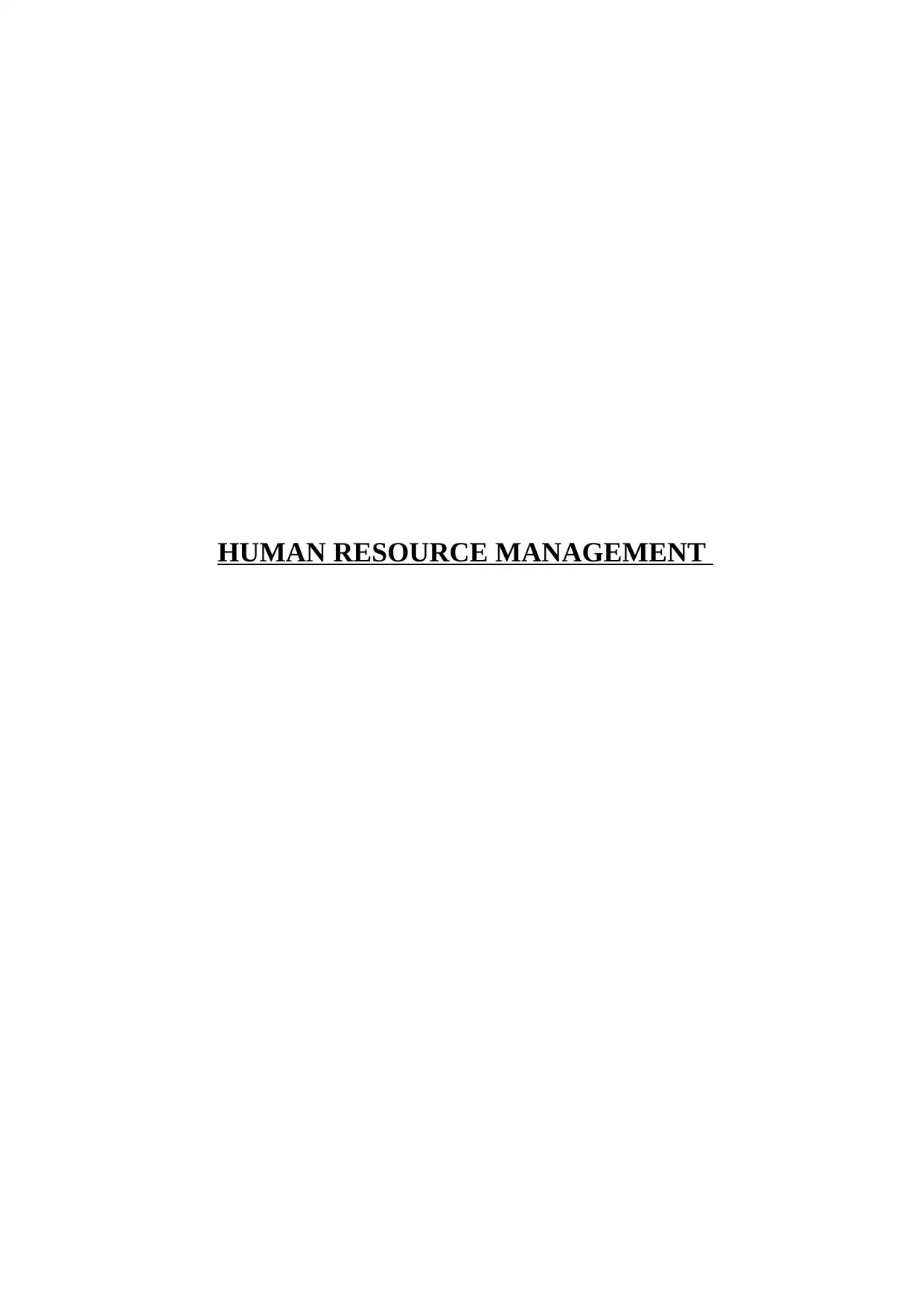
HUMAN RESOURCE MANAGEMENT
Secure Best Marks with AI Grader
Need help grading? Try our AI Grader for instant feedback on your assignments.
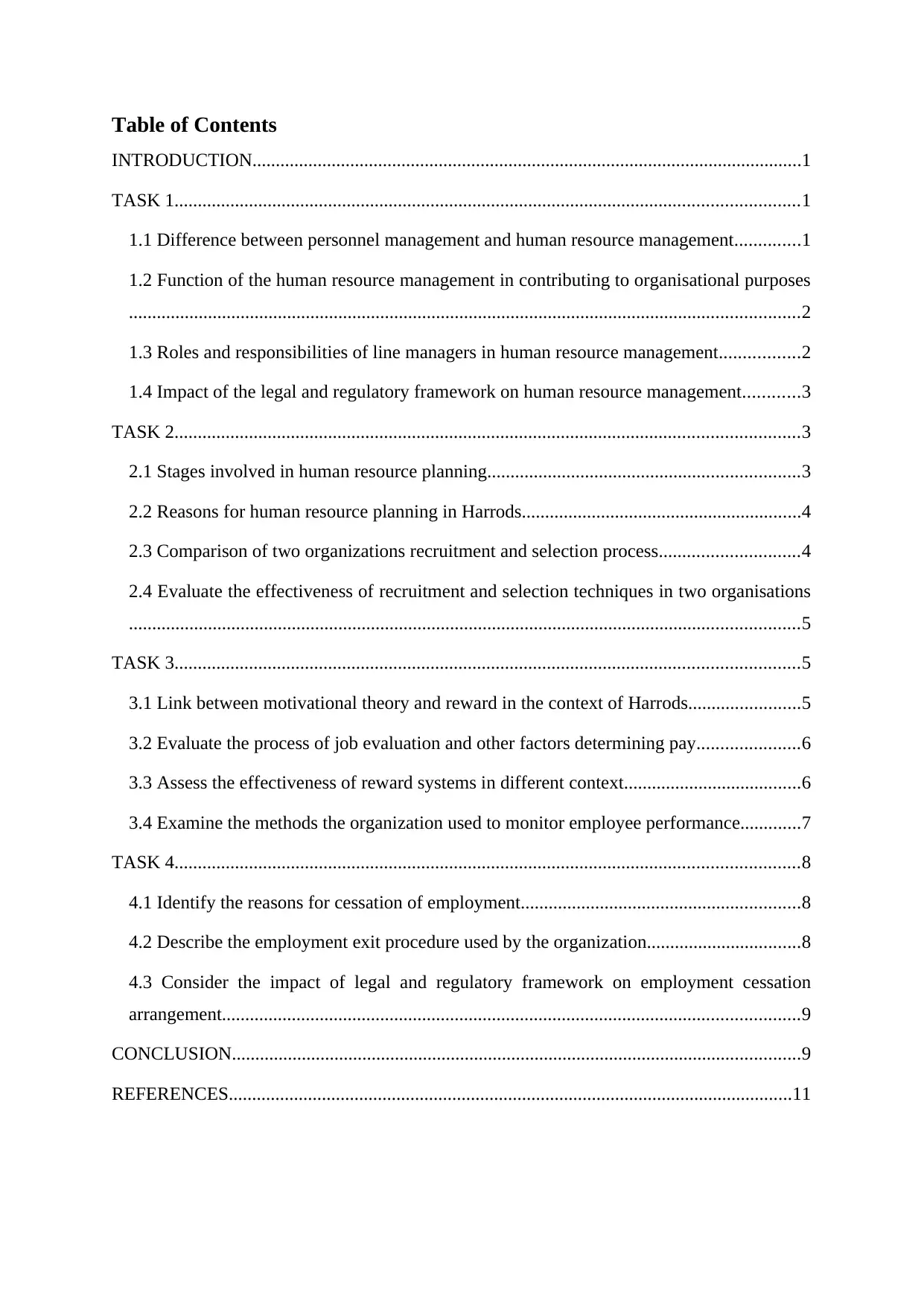
Table of Contents
INTRODUCTION......................................................................................................................1
TASK 1......................................................................................................................................1
1.1 Difference between personnel management and human resource management..............1
1.2 Function of the human resource management in contributing to organisational purposes
................................................................................................................................................2
1.3 Roles and responsibilities of line managers in human resource management.................2
1.4 Impact of the legal and regulatory framework on human resource management............3
TASK 2......................................................................................................................................3
2.1 Stages involved in human resource planning...................................................................3
2.2 Reasons for human resource planning in Harrods............................................................4
2.3 Comparison of two organizations recruitment and selection process..............................4
2.4 Evaluate the effectiveness of recruitment and selection techniques in two organisations
................................................................................................................................................5
TASK 3......................................................................................................................................5
3.1 Link between motivational theory and reward in the context of Harrods........................5
3.2 Evaluate the process of job evaluation and other factors determining pay......................6
3.3 Assess the effectiveness of reward systems in different context......................................6
3.4 Examine the methods the organization used to monitor employee performance.............7
TASK 4......................................................................................................................................8
4.1 Identify the reasons for cessation of employment............................................................8
4.2 Describe the employment exit procedure used by the organization.................................8
4.3 Consider the impact of legal and regulatory framework on employment cessation
arrangement............................................................................................................................9
CONCLUSION..........................................................................................................................9
REFERENCES.........................................................................................................................11
INTRODUCTION......................................................................................................................1
TASK 1......................................................................................................................................1
1.1 Difference between personnel management and human resource management..............1
1.2 Function of the human resource management in contributing to organisational purposes
................................................................................................................................................2
1.3 Roles and responsibilities of line managers in human resource management.................2
1.4 Impact of the legal and regulatory framework on human resource management............3
TASK 2......................................................................................................................................3
2.1 Stages involved in human resource planning...................................................................3
2.2 Reasons for human resource planning in Harrods............................................................4
2.3 Comparison of two organizations recruitment and selection process..............................4
2.4 Evaluate the effectiveness of recruitment and selection techniques in two organisations
................................................................................................................................................5
TASK 3......................................................................................................................................5
3.1 Link between motivational theory and reward in the context of Harrods........................5
3.2 Evaluate the process of job evaluation and other factors determining pay......................6
3.3 Assess the effectiveness of reward systems in different context......................................6
3.4 Examine the methods the organization used to monitor employee performance.............7
TASK 4......................................................................................................................................8
4.1 Identify the reasons for cessation of employment............................................................8
4.2 Describe the employment exit procedure used by the organization.................................8
4.3 Consider the impact of legal and regulatory framework on employment cessation
arrangement............................................................................................................................9
CONCLUSION..........................................................................................................................9
REFERENCES.........................................................................................................................11
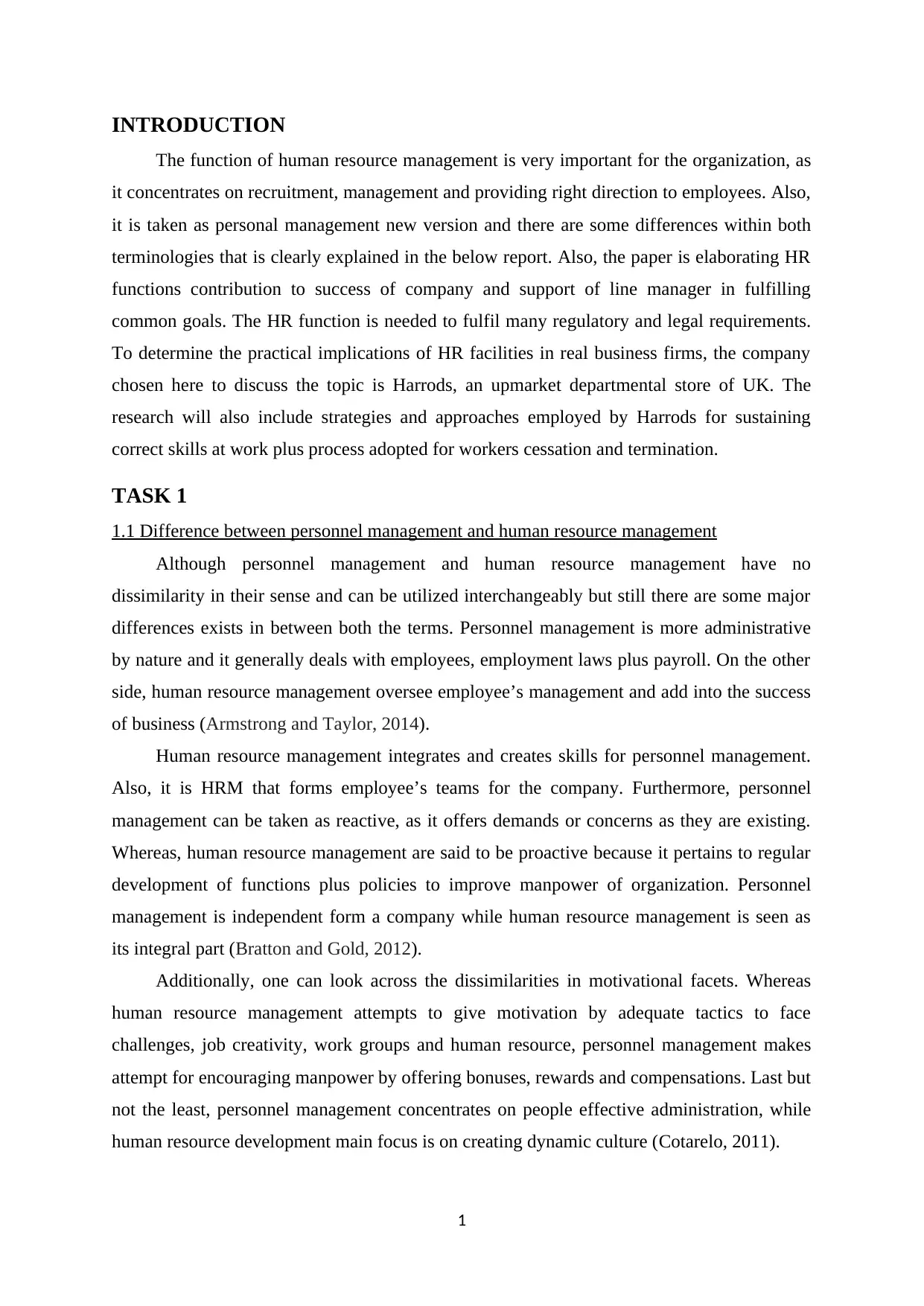
INTRODUCTION
The function of human resource management is very important for the organization, as
it concentrates on recruitment, management and providing right direction to employees. Also,
it is taken as personal management new version and there are some differences within both
terminologies that is clearly explained in the below report. Also, the paper is elaborating HR
functions contribution to success of company and support of line manager in fulfilling
common goals. The HR function is needed to fulfil many regulatory and legal requirements.
To determine the practical implications of HR facilities in real business firms, the company
chosen here to discuss the topic is Harrods, an upmarket departmental store of UK. The
research will also include strategies and approaches employed by Harrods for sustaining
correct skills at work plus process adopted for workers cessation and termination.
TASK 1
1.1 Difference between personnel management and human resource management
Although personnel management and human resource management have no
dissimilarity in their sense and can be utilized interchangeably but still there are some major
differences exists in between both the terms. Personnel management is more administrative
by nature and it generally deals with employees, employment laws plus payroll. On the other
side, human resource management oversee employee’s management and add into the success
of business (Armstrong and Taylor, 2014).
Human resource management integrates and creates skills for personnel management.
Also, it is HRM that forms employee’s teams for the company. Furthermore, personnel
management can be taken as reactive, as it offers demands or concerns as they are existing.
Whereas, human resource management are said to be proactive because it pertains to regular
development of functions plus policies to improve manpower of organization. Personnel
management is independent form a company while human resource management is seen as
its integral part (Bratton and Gold, 2012).
Additionally, one can look across the dissimilarities in motivational facets. Whereas
human resource management attempts to give motivation by adequate tactics to face
challenges, job creativity, work groups and human resource, personnel management makes
attempt for encouraging manpower by offering bonuses, rewards and compensations. Last but
not the least, personnel management concentrates on people effective administration, while
human resource development main focus is on creating dynamic culture (Cotarelo, 2011).
1
The function of human resource management is very important for the organization, as
it concentrates on recruitment, management and providing right direction to employees. Also,
it is taken as personal management new version and there are some differences within both
terminologies that is clearly explained in the below report. Also, the paper is elaborating HR
functions contribution to success of company and support of line manager in fulfilling
common goals. The HR function is needed to fulfil many regulatory and legal requirements.
To determine the practical implications of HR facilities in real business firms, the company
chosen here to discuss the topic is Harrods, an upmarket departmental store of UK. The
research will also include strategies and approaches employed by Harrods for sustaining
correct skills at work plus process adopted for workers cessation and termination.
TASK 1
1.1 Difference between personnel management and human resource management
Although personnel management and human resource management have no
dissimilarity in their sense and can be utilized interchangeably but still there are some major
differences exists in between both the terms. Personnel management is more administrative
by nature and it generally deals with employees, employment laws plus payroll. On the other
side, human resource management oversee employee’s management and add into the success
of business (Armstrong and Taylor, 2014).
Human resource management integrates and creates skills for personnel management.
Also, it is HRM that forms employee’s teams for the company. Furthermore, personnel
management can be taken as reactive, as it offers demands or concerns as they are existing.
Whereas, human resource management are said to be proactive because it pertains to regular
development of functions plus policies to improve manpower of organization. Personnel
management is independent form a company while human resource management is seen as
its integral part (Bratton and Gold, 2012).
Additionally, one can look across the dissimilarities in motivational facets. Whereas
human resource management attempts to give motivation by adequate tactics to face
challenges, job creativity, work groups and human resource, personnel management makes
attempt for encouraging manpower by offering bonuses, rewards and compensations. Last but
not the least, personnel management concentrates on people effective administration, while
human resource development main focus is on creating dynamic culture (Cotarelo, 2011).
1
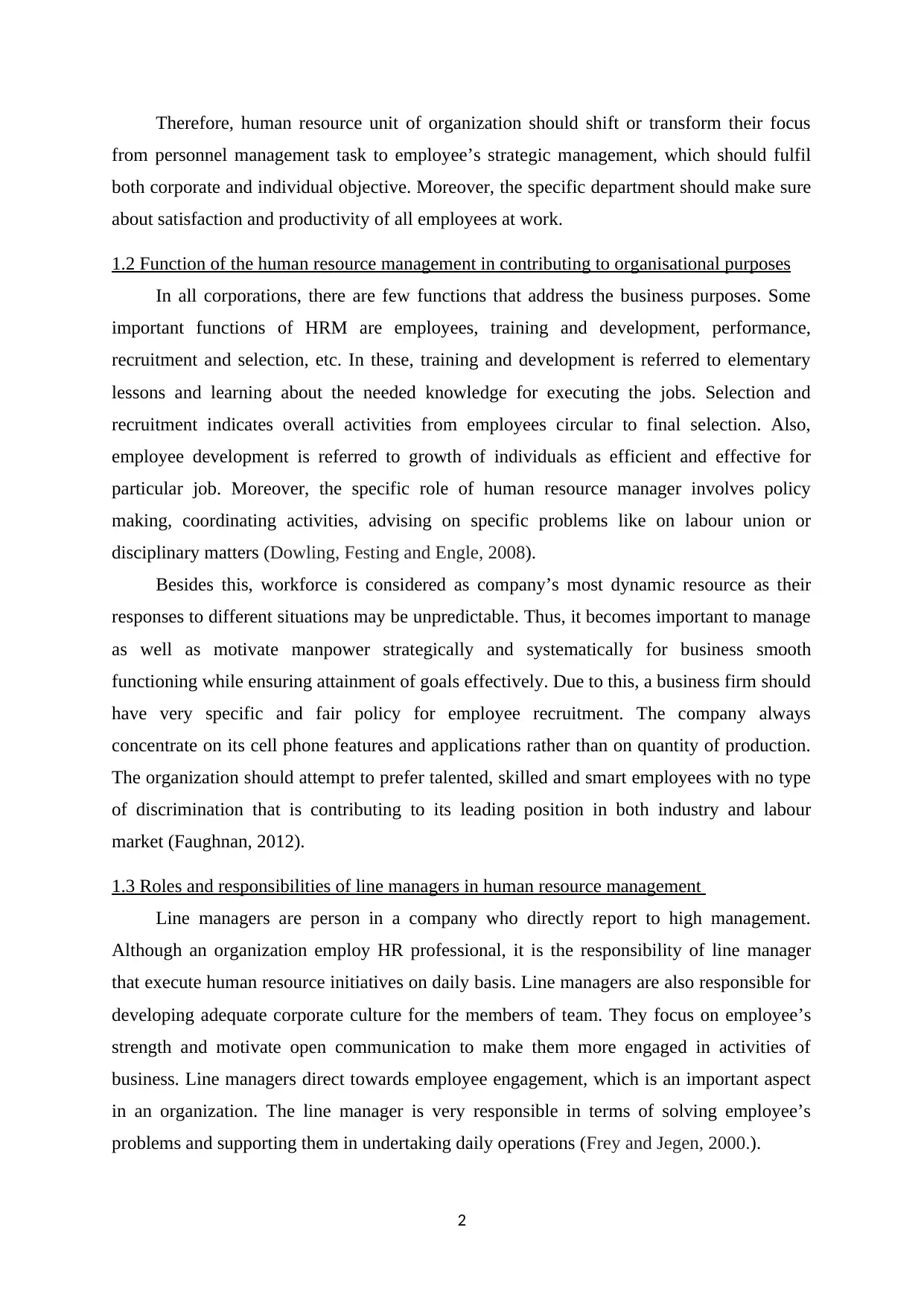
Therefore, human resource unit of organization should shift or transform their focus
from personnel management task to employee’s strategic management, which should fulfil
both corporate and individual objective. Moreover, the specific department should make sure
about satisfaction and productivity of all employees at work.
1.2 Function of the human resource management in contributing to organisational purposes
In all corporations, there are few functions that address the business purposes. Some
important functions of HRM are employees, training and development, performance,
recruitment and selection, etc. In these, training and development is referred to elementary
lessons and learning about the needed knowledge for executing the jobs. Selection and
recruitment indicates overall activities from employees circular to final selection. Also,
employee development is referred to growth of individuals as efficient and effective for
particular job. Moreover, the specific role of human resource manager involves policy
making, coordinating activities, advising on specific problems like on labour union or
disciplinary matters (Dowling, Festing and Engle, 2008).
Besides this, workforce is considered as company’s most dynamic resource as their
responses to different situations may be unpredictable. Thus, it becomes important to manage
as well as motivate manpower strategically and systematically for business smooth
functioning while ensuring attainment of goals effectively. Due to this, a business firm should
have very specific and fair policy for employee recruitment. The company always
concentrate on its cell phone features and applications rather than on quantity of production.
The organization should attempt to prefer talented, skilled and smart employees with no type
of discrimination that is contributing to its leading position in both industry and labour
market (Faughnan, 2012).
1.3 Roles and responsibilities of line managers in human resource management
Line managers are person in a company who directly report to high management.
Although an organization employ HR professional, it is the responsibility of line manager
that execute human resource initiatives on daily basis. Line managers are also responsible for
developing adequate corporate culture for the members of team. They focus on employee’s
strength and motivate open communication to make them more engaged in activities of
business. Line managers direct towards employee engagement, which is an important aspect
in an organization. The line manager is very responsible in terms of solving employee’s
problems and supporting them in undertaking daily operations (Frey and Jegen, 2000.).
2
from personnel management task to employee’s strategic management, which should fulfil
both corporate and individual objective. Moreover, the specific department should make sure
about satisfaction and productivity of all employees at work.
1.2 Function of the human resource management in contributing to organisational purposes
In all corporations, there are few functions that address the business purposes. Some
important functions of HRM are employees, training and development, performance,
recruitment and selection, etc. In these, training and development is referred to elementary
lessons and learning about the needed knowledge for executing the jobs. Selection and
recruitment indicates overall activities from employees circular to final selection. Also,
employee development is referred to growth of individuals as efficient and effective for
particular job. Moreover, the specific role of human resource manager involves policy
making, coordinating activities, advising on specific problems like on labour union or
disciplinary matters (Dowling, Festing and Engle, 2008).
Besides this, workforce is considered as company’s most dynamic resource as their
responses to different situations may be unpredictable. Thus, it becomes important to manage
as well as motivate manpower strategically and systematically for business smooth
functioning while ensuring attainment of goals effectively. Due to this, a business firm should
have very specific and fair policy for employee recruitment. The company always
concentrate on its cell phone features and applications rather than on quantity of production.
The organization should attempt to prefer talented, skilled and smart employees with no type
of discrimination that is contributing to its leading position in both industry and labour
market (Faughnan, 2012).
1.3 Roles and responsibilities of line managers in human resource management
Line managers are person in a company who directly report to high management.
Although an organization employ HR professional, it is the responsibility of line manager
that execute human resource initiatives on daily basis. Line managers are also responsible for
developing adequate corporate culture for the members of team. They focus on employee’s
strength and motivate open communication to make them more engaged in activities of
business. Line managers direct towards employee engagement, which is an important aspect
in an organization. The line manager is very responsible in terms of solving employee’s
problems and supporting them in undertaking daily operations (Frey and Jegen, 2000.).
2
Secure Best Marks with AI Grader
Need help grading? Try our AI Grader for instant feedback on your assignments.
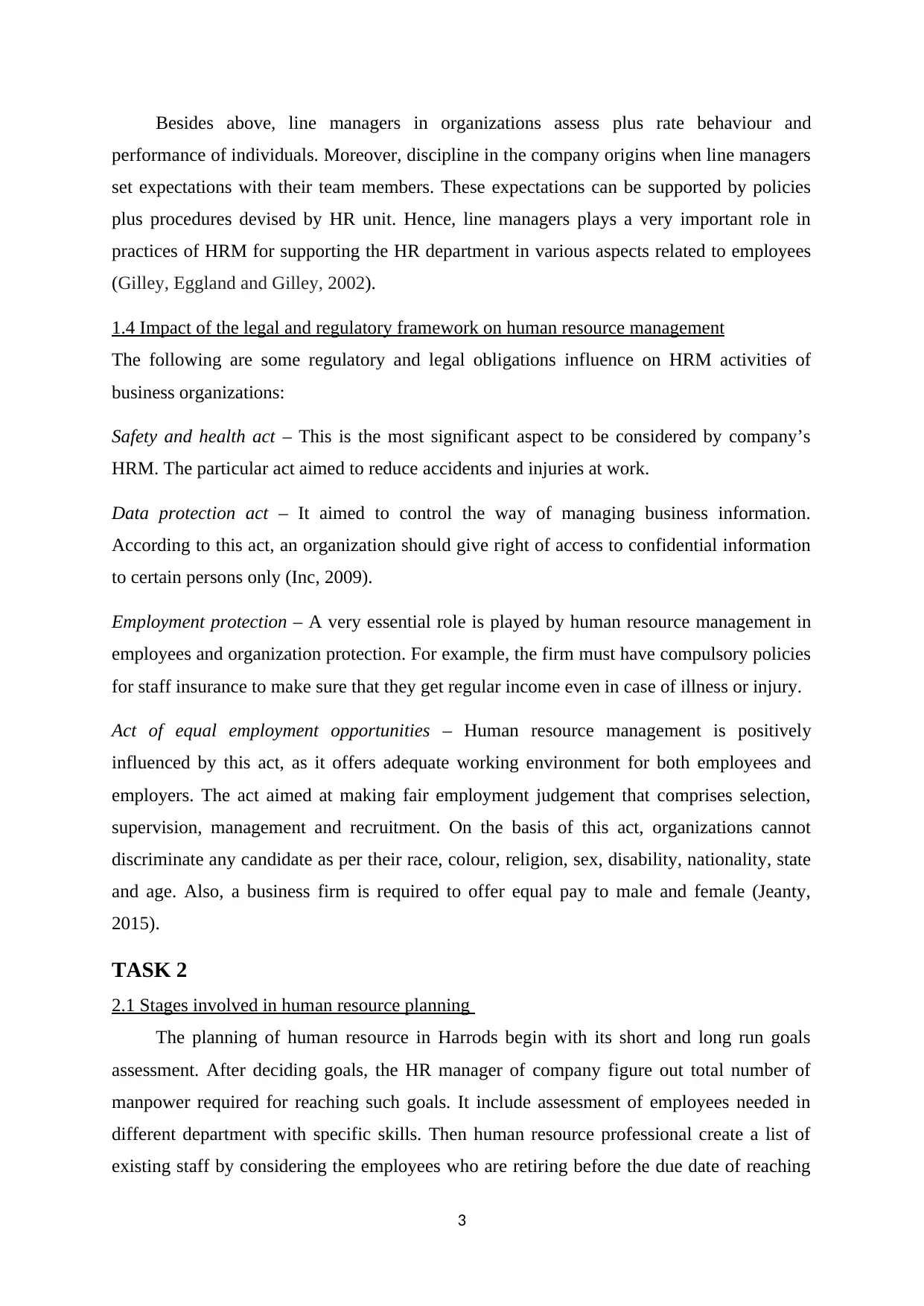
Besides above, line managers in organizations assess plus rate behaviour and
performance of individuals. Moreover, discipline in the company origins when line managers
set expectations with their team members. These expectations can be supported by policies
plus procedures devised by HR unit. Hence, line managers plays a very important role in
practices of HRM for supporting the HR department in various aspects related to employees
(Gilley, Eggland and Gilley, 2002).
1.4 Impact of the legal and regulatory framework on human resource management
The following are some regulatory and legal obligations influence on HRM activities of
business organizations:
Safety and health act – This is the most significant aspect to be considered by company’s
HRM. The particular act aimed to reduce accidents and injuries at work.
Data protection act – It aimed to control the way of managing business information.
According to this act, an organization should give right of access to confidential information
to certain persons only (Inc, 2009).
Employment protection – A very essential role is played by human resource management in
employees and organization protection. For example, the firm must have compulsory policies
for staff insurance to make sure that they get regular income even in case of illness or injury.
Act of equal employment opportunities – Human resource management is positively
influenced by this act, as it offers adequate working environment for both employees and
employers. The act aimed at making fair employment judgement that comprises selection,
supervision, management and recruitment. On the basis of this act, organizations cannot
discriminate any candidate as per their race, colour, religion, sex, disability, nationality, state
and age. Also, a business firm is required to offer equal pay to male and female (Jeanty,
2015).
TASK 2
2.1 Stages involved in human resource planning
The planning of human resource in Harrods begin with its short and long run goals
assessment. After deciding goals, the HR manager of company figure out total number of
manpower required for reaching such goals. It include assessment of employees needed in
different department with specific skills. Then human resource professional create a list of
existing staff by considering the employees who are retiring before the due date of reaching
3
performance of individuals. Moreover, discipline in the company origins when line managers
set expectations with their team members. These expectations can be supported by policies
plus procedures devised by HR unit. Hence, line managers plays a very important role in
practices of HRM for supporting the HR department in various aspects related to employees
(Gilley, Eggland and Gilley, 2002).
1.4 Impact of the legal and regulatory framework on human resource management
The following are some regulatory and legal obligations influence on HRM activities of
business organizations:
Safety and health act – This is the most significant aspect to be considered by company’s
HRM. The particular act aimed to reduce accidents and injuries at work.
Data protection act – It aimed to control the way of managing business information.
According to this act, an organization should give right of access to confidential information
to certain persons only (Inc, 2009).
Employment protection – A very essential role is played by human resource management in
employees and organization protection. For example, the firm must have compulsory policies
for staff insurance to make sure that they get regular income even in case of illness or injury.
Act of equal employment opportunities – Human resource management is positively
influenced by this act, as it offers adequate working environment for both employees and
employers. The act aimed at making fair employment judgement that comprises selection,
supervision, management and recruitment. On the basis of this act, organizations cannot
discriminate any candidate as per their race, colour, religion, sex, disability, nationality, state
and age. Also, a business firm is required to offer equal pay to male and female (Jeanty,
2015).
TASK 2
2.1 Stages involved in human resource planning
The planning of human resource in Harrods begin with its short and long run goals
assessment. After deciding goals, the HR manager of company figure out total number of
manpower required for reaching such goals. It include assessment of employees needed in
different department with specific skills. Then human resource professional create a list of
existing staff by considering the employees who are retiring before the due date of reaching
3
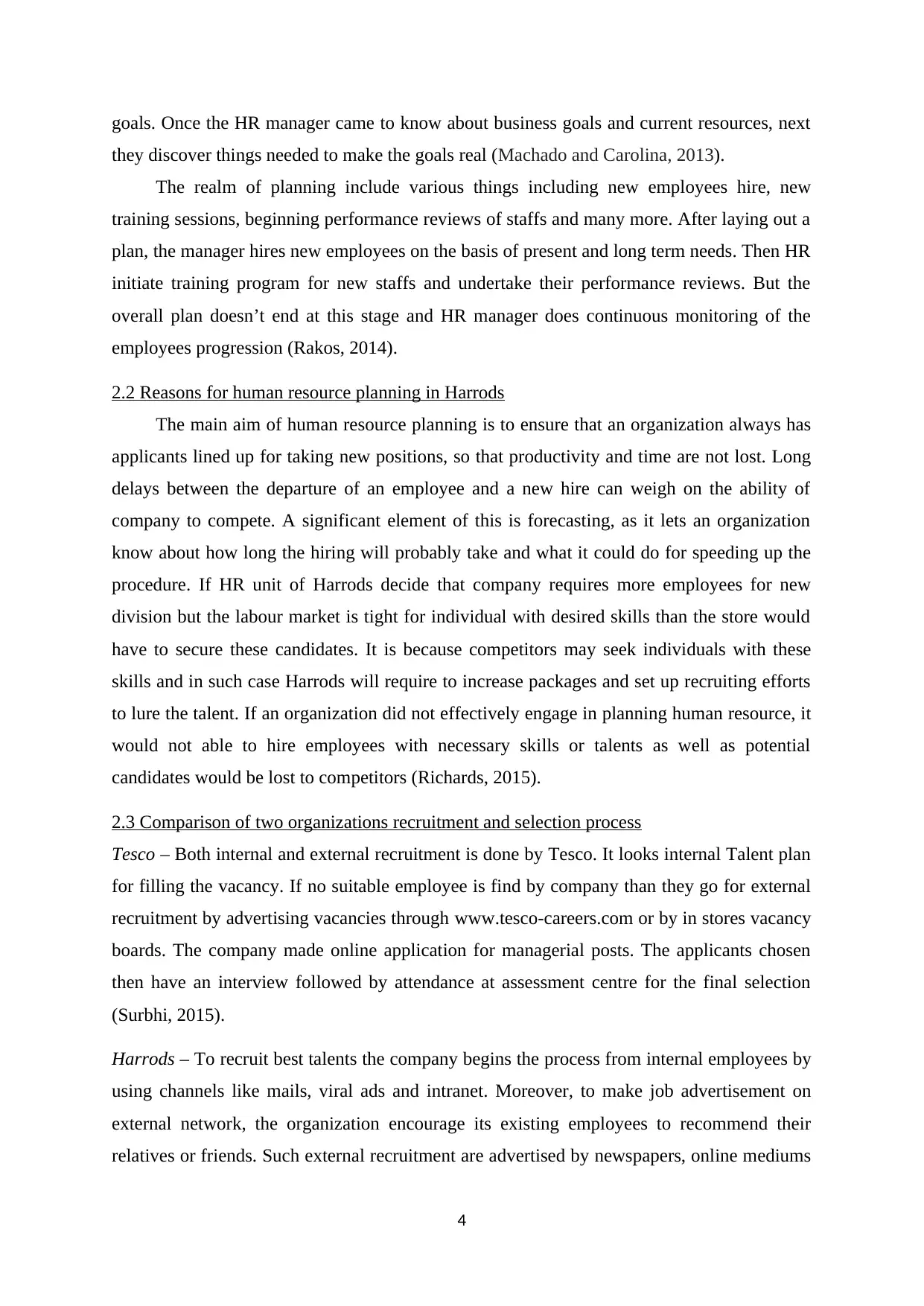
goals. Once the HR manager came to know about business goals and current resources, next
they discover things needed to make the goals real (Machado and Carolina, 2013).
The realm of planning include various things including new employees hire, new
training sessions, beginning performance reviews of staffs and many more. After laying out a
plan, the manager hires new employees on the basis of present and long term needs. Then HR
initiate training program for new staffs and undertake their performance reviews. But the
overall plan doesn’t end at this stage and HR manager does continuous monitoring of the
employees progression (Rakos, 2014).
2.2 Reasons for human resource planning in Harrods
The main aim of human resource planning is to ensure that an organization always has
applicants lined up for taking new positions, so that productivity and time are not lost. Long
delays between the departure of an employee and a new hire can weigh on the ability of
company to compete. A significant element of this is forecasting, as it lets an organization
know about how long the hiring will probably take and what it could do for speeding up the
procedure. If HR unit of Harrods decide that company requires more employees for new
division but the labour market is tight for individual with desired skills than the store would
have to secure these candidates. It is because competitors may seek individuals with these
skills and in such case Harrods will require to increase packages and set up recruiting efforts
to lure the talent. If an organization did not effectively engage in planning human resource, it
would not able to hire employees with necessary skills or talents as well as potential
candidates would be lost to competitors (Richards, 2015).
2.3 Comparison of two organizations recruitment and selection process
Tesco – Both internal and external recruitment is done by Tesco. It looks internal Talent plan
for filling the vacancy. If no suitable employee is find by company than they go for external
recruitment by advertising vacancies through www.tesco-careers.com or by in stores vacancy
boards. The company made online application for managerial posts. The applicants chosen
then have an interview followed by attendance at assessment centre for the final selection
(Surbhi, 2015).
Harrods – To recruit best talents the company begins the process from internal employees by
using channels like mails, viral ads and intranet. Moreover, to make job advertisement on
external network, the organization encourage its existing employees to recommend their
relatives or friends. Such external recruitment are advertised by newspapers, online mediums
4
they discover things needed to make the goals real (Machado and Carolina, 2013).
The realm of planning include various things including new employees hire, new
training sessions, beginning performance reviews of staffs and many more. After laying out a
plan, the manager hires new employees on the basis of present and long term needs. Then HR
initiate training program for new staffs and undertake their performance reviews. But the
overall plan doesn’t end at this stage and HR manager does continuous monitoring of the
employees progression (Rakos, 2014).
2.2 Reasons for human resource planning in Harrods
The main aim of human resource planning is to ensure that an organization always has
applicants lined up for taking new positions, so that productivity and time are not lost. Long
delays between the departure of an employee and a new hire can weigh on the ability of
company to compete. A significant element of this is forecasting, as it lets an organization
know about how long the hiring will probably take and what it could do for speeding up the
procedure. If HR unit of Harrods decide that company requires more employees for new
division but the labour market is tight for individual with desired skills than the store would
have to secure these candidates. It is because competitors may seek individuals with these
skills and in such case Harrods will require to increase packages and set up recruiting efforts
to lure the talent. If an organization did not effectively engage in planning human resource, it
would not able to hire employees with necessary skills or talents as well as potential
candidates would be lost to competitors (Richards, 2015).
2.3 Comparison of two organizations recruitment and selection process
Tesco – Both internal and external recruitment is done by Tesco. It looks internal Talent plan
for filling the vacancy. If no suitable employee is find by company than they go for external
recruitment by advertising vacancies through www.tesco-careers.com or by in stores vacancy
boards. The company made online application for managerial posts. The applicants chosen
then have an interview followed by attendance at assessment centre for the final selection
(Surbhi, 2015).
Harrods – To recruit best talents the company begins the process from internal employees by
using channels like mails, viral ads and intranet. Moreover, to make job advertisement on
external network, the organization encourage its existing employees to recommend their
relatives or friends. Such external recruitment are advertised by newspapers, online mediums
4
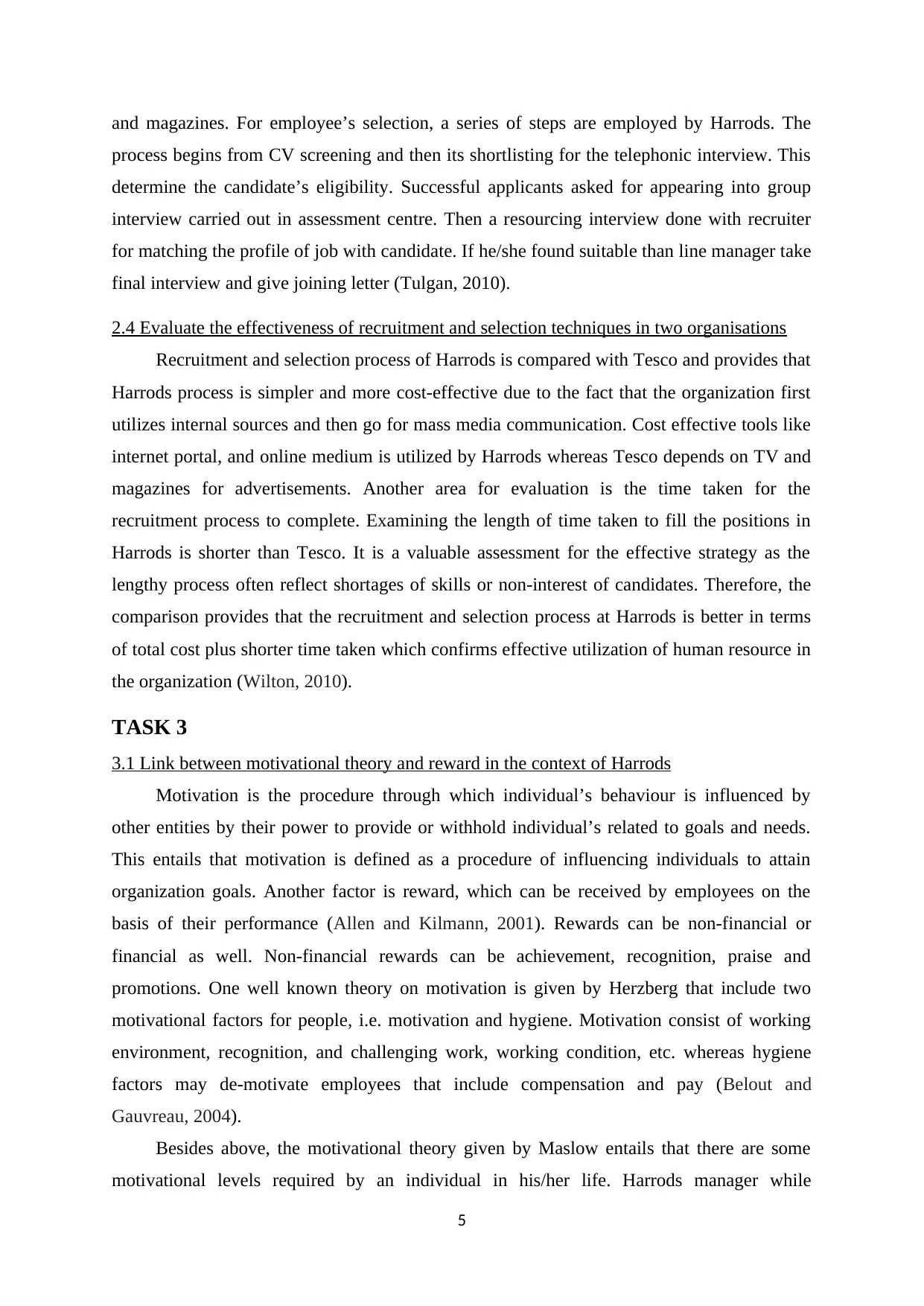
and magazines. For employee’s selection, a series of steps are employed by Harrods. The
process begins from CV screening and then its shortlisting for the telephonic interview. This
determine the candidate’s eligibility. Successful applicants asked for appearing into group
interview carried out in assessment centre. Then a resourcing interview done with recruiter
for matching the profile of job with candidate. If he/she found suitable than line manager take
final interview and give joining letter (Tulgan, 2010).
2.4 Evaluate the effectiveness of recruitment and selection techniques in two organisations
Recruitment and selection process of Harrods is compared with Tesco and provides that
Harrods process is simpler and more cost-effective due to the fact that the organization first
utilizes internal sources and then go for mass media communication. Cost effective tools like
internet portal, and online medium is utilized by Harrods whereas Tesco depends on TV and
magazines for advertisements. Another area for evaluation is the time taken for the
recruitment process to complete. Examining the length of time taken to fill the positions in
Harrods is shorter than Tesco. It is a valuable assessment for the effective strategy as the
lengthy process often reflect shortages of skills or non-interest of candidates. Therefore, the
comparison provides that the recruitment and selection process at Harrods is better in terms
of total cost plus shorter time taken which confirms effective utilization of human resource in
the organization (Wilton, 2010).
TASK 3
3.1 Link between motivational theory and reward in the context of Harrods
Motivation is the procedure through which individual’s behaviour is influenced by
other entities by their power to provide or withhold individual’s related to goals and needs.
This entails that motivation is defined as a procedure of influencing individuals to attain
organization goals. Another factor is reward, which can be received by employees on the
basis of their performance (Allen and Kilmann, 2001). Rewards can be non-financial or
financial as well. Non-financial rewards can be achievement, recognition, praise and
promotions. One well known theory on motivation is given by Herzberg that include two
motivational factors for people, i.e. motivation and hygiene. Motivation consist of working
environment, recognition, and challenging work, working condition, etc. whereas hygiene
factors may de-motivate employees that include compensation and pay (Belout and
Gauvreau, 2004).
Besides above, the motivational theory given by Maslow entails that there are some
motivational levels required by an individual in his/her life. Harrods manager while
5
process begins from CV screening and then its shortlisting for the telephonic interview. This
determine the candidate’s eligibility. Successful applicants asked for appearing into group
interview carried out in assessment centre. Then a resourcing interview done with recruiter
for matching the profile of job with candidate. If he/she found suitable than line manager take
final interview and give joining letter (Tulgan, 2010).
2.4 Evaluate the effectiveness of recruitment and selection techniques in two organisations
Recruitment and selection process of Harrods is compared with Tesco and provides that
Harrods process is simpler and more cost-effective due to the fact that the organization first
utilizes internal sources and then go for mass media communication. Cost effective tools like
internet portal, and online medium is utilized by Harrods whereas Tesco depends on TV and
magazines for advertisements. Another area for evaluation is the time taken for the
recruitment process to complete. Examining the length of time taken to fill the positions in
Harrods is shorter than Tesco. It is a valuable assessment for the effective strategy as the
lengthy process often reflect shortages of skills or non-interest of candidates. Therefore, the
comparison provides that the recruitment and selection process at Harrods is better in terms
of total cost plus shorter time taken which confirms effective utilization of human resource in
the organization (Wilton, 2010).
TASK 3
3.1 Link between motivational theory and reward in the context of Harrods
Motivation is the procedure through which individual’s behaviour is influenced by
other entities by their power to provide or withhold individual’s related to goals and needs.
This entails that motivation is defined as a procedure of influencing individuals to attain
organization goals. Another factor is reward, which can be received by employees on the
basis of their performance (Allen and Kilmann, 2001). Rewards can be non-financial or
financial as well. Non-financial rewards can be achievement, recognition, praise and
promotions. One well known theory on motivation is given by Herzberg that include two
motivational factors for people, i.e. motivation and hygiene. Motivation consist of working
environment, recognition, and challenging work, working condition, etc. whereas hygiene
factors may de-motivate employees that include compensation and pay (Belout and
Gauvreau, 2004).
Besides above, the motivational theory given by Maslow entails that there are some
motivational levels required by an individual in his/her life. Harrods manager while
5
Paraphrase This Document
Need a fresh take? Get an instant paraphrase of this document with our AI Paraphraser
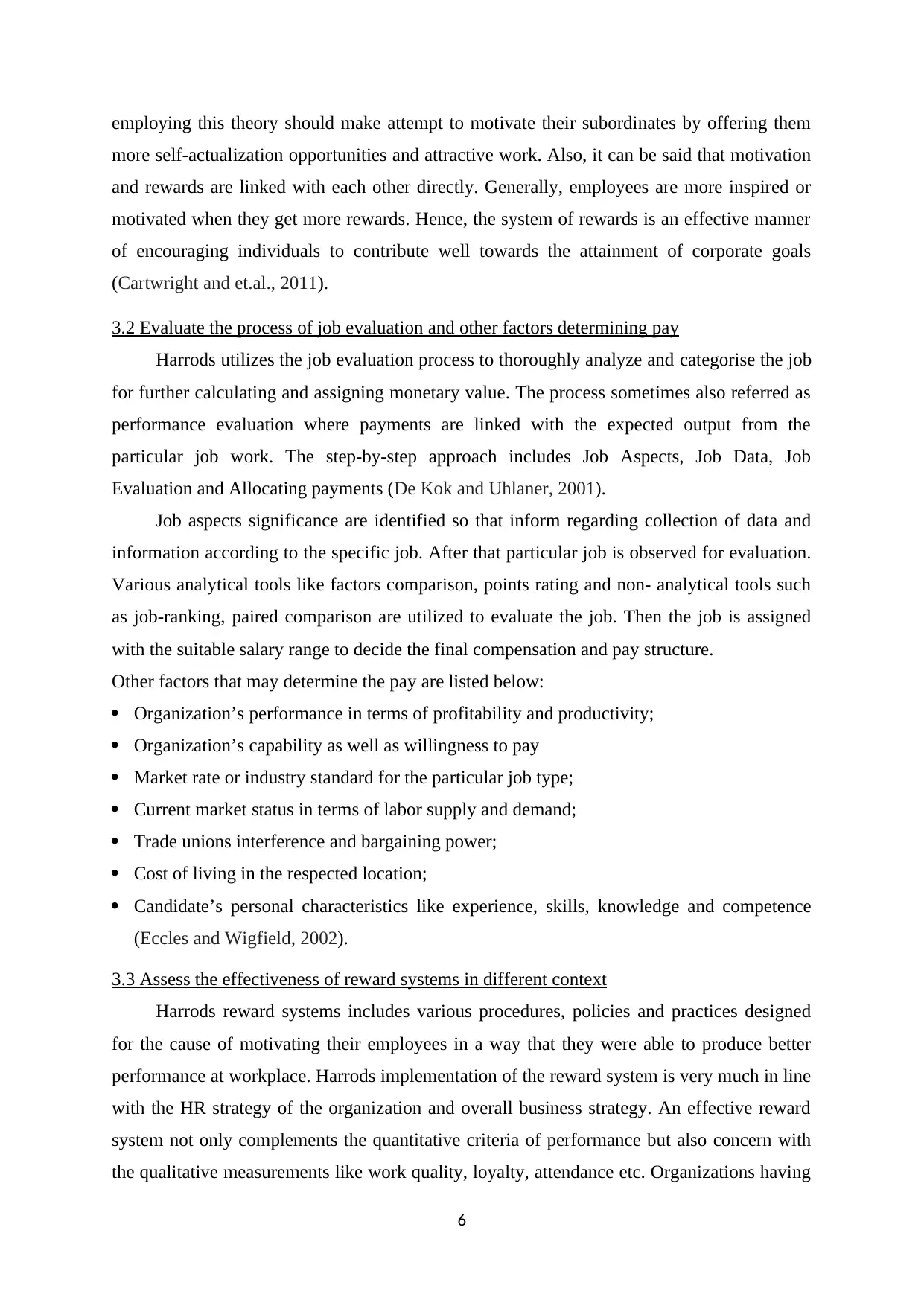
employing this theory should make attempt to motivate their subordinates by offering them
more self-actualization opportunities and attractive work. Also, it can be said that motivation
and rewards are linked with each other directly. Generally, employees are more inspired or
motivated when they get more rewards. Hence, the system of rewards is an effective manner
of encouraging individuals to contribute well towards the attainment of corporate goals
(Cartwright and et.al., 2011).
3.2 Evaluate the process of job evaluation and other factors determining pay
Harrods utilizes the job evaluation process to thoroughly analyze and categorise the job
for further calculating and assigning monetary value. The process sometimes also referred as
performance evaluation where payments are linked with the expected output from the
particular job work. The step-by-step approach includes Job Aspects, Job Data, Job
Evaluation and Allocating payments (De Kok and Uhlaner, 2001).
Job aspects significance are identified so that inform regarding collection of data and
information according to the specific job. After that particular job is observed for evaluation.
Various analytical tools like factors comparison, points rating and non- analytical tools such
as job-ranking, paired comparison are utilized to evaluate the job. Then the job is assigned
with the suitable salary range to decide the final compensation and pay structure.
Other factors that may determine the pay are listed below:
Organization’s performance in terms of profitability and productivity;
Organization’s capability as well as willingness to pay
Market rate or industry standard for the particular job type;
Current market status in terms of labor supply and demand;
Trade unions interference and bargaining power;
Cost of living in the respected location;
Candidate’s personal characteristics like experience, skills, knowledge and competence
(Eccles and Wigfield, 2002).
3.3 Assess the effectiveness of reward systems in different context
Harrods reward systems includes various procedures, policies and practices designed
for the cause of motivating their employees in a way that they were able to produce better
performance at workplace. Harrods implementation of the reward system is very much in line
with the HR strategy of the organization and overall business strategy. An effective reward
system not only complements the quantitative criteria of performance but also concern with
the qualitative measurements like work quality, loyalty, attendance etc. Organizations having
6
more self-actualization opportunities and attractive work. Also, it can be said that motivation
and rewards are linked with each other directly. Generally, employees are more inspired or
motivated when they get more rewards. Hence, the system of rewards is an effective manner
of encouraging individuals to contribute well towards the attainment of corporate goals
(Cartwright and et.al., 2011).
3.2 Evaluate the process of job evaluation and other factors determining pay
Harrods utilizes the job evaluation process to thoroughly analyze and categorise the job
for further calculating and assigning monetary value. The process sometimes also referred as
performance evaluation where payments are linked with the expected output from the
particular job work. The step-by-step approach includes Job Aspects, Job Data, Job
Evaluation and Allocating payments (De Kok and Uhlaner, 2001).
Job aspects significance are identified so that inform regarding collection of data and
information according to the specific job. After that particular job is observed for evaluation.
Various analytical tools like factors comparison, points rating and non- analytical tools such
as job-ranking, paired comparison are utilized to evaluate the job. Then the job is assigned
with the suitable salary range to decide the final compensation and pay structure.
Other factors that may determine the pay are listed below:
Organization’s performance in terms of profitability and productivity;
Organization’s capability as well as willingness to pay
Market rate or industry standard for the particular job type;
Current market status in terms of labor supply and demand;
Trade unions interference and bargaining power;
Cost of living in the respected location;
Candidate’s personal characteristics like experience, skills, knowledge and competence
(Eccles and Wigfield, 2002).
3.3 Assess the effectiveness of reward systems in different context
Harrods reward systems includes various procedures, policies and practices designed
for the cause of motivating their employees in a way that they were able to produce better
performance at workplace. Harrods implementation of the reward system is very much in line
with the HR strategy of the organization and overall business strategy. An effective reward
system not only complements the quantitative criteria of performance but also concern with
the qualitative measurements like work quality, loyalty, attendance etc. Organizations having
6
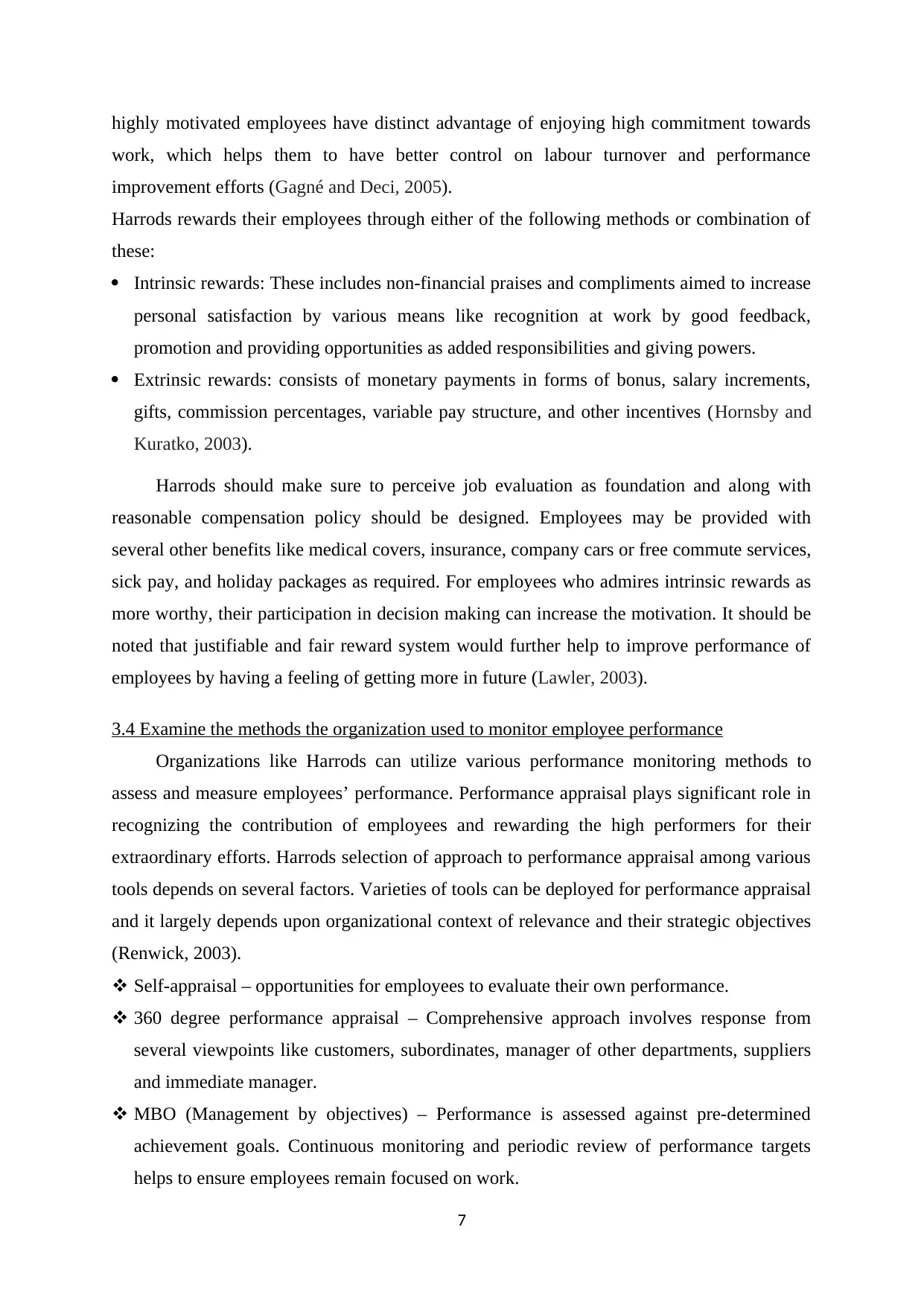
highly motivated employees have distinct advantage of enjoying high commitment towards
work, which helps them to have better control on labour turnover and performance
improvement efforts (Gagné and Deci, 2005).
Harrods rewards their employees through either of the following methods or combination of
these:
Intrinsic rewards: These includes non-financial praises and compliments aimed to increase
personal satisfaction by various means like recognition at work by good feedback,
promotion and providing opportunities as added responsibilities and giving powers.
Extrinsic rewards: consists of monetary payments in forms of bonus, salary increments,
gifts, commission percentages, variable pay structure, and other incentives (Hornsby and
Kuratko, 2003).
Harrods should make sure to perceive job evaluation as foundation and along with
reasonable compensation policy should be designed. Employees may be provided with
several other benefits like medical covers, insurance, company cars or free commute services,
sick pay, and holiday packages as required. For employees who admires intrinsic rewards as
more worthy, their participation in decision making can increase the motivation. It should be
noted that justifiable and fair reward system would further help to improve performance of
employees by having a feeling of getting more in future (Lawler, 2003).
3.4 Examine the methods the organization used to monitor employee performance
Organizations like Harrods can utilize various performance monitoring methods to
assess and measure employees’ performance. Performance appraisal plays significant role in
recognizing the contribution of employees and rewarding the high performers for their
extraordinary efforts. Harrods selection of approach to performance appraisal among various
tools depends on several factors. Varieties of tools can be deployed for performance appraisal
and it largely depends upon organizational context of relevance and their strategic objectives
(Renwick, 2003).
Self-appraisal – opportunities for employees to evaluate their own performance.
360 degree performance appraisal – Comprehensive approach involves response from
several viewpoints like customers, subordinates, manager of other departments, suppliers
and immediate manager.
MBO (Management by objectives) – Performance is assessed against pre-determined
achievement goals. Continuous monitoring and periodic review of performance targets
helps to ensure employees remain focused on work.
7
work, which helps them to have better control on labour turnover and performance
improvement efforts (Gagné and Deci, 2005).
Harrods rewards their employees through either of the following methods or combination of
these:
Intrinsic rewards: These includes non-financial praises and compliments aimed to increase
personal satisfaction by various means like recognition at work by good feedback,
promotion and providing opportunities as added responsibilities and giving powers.
Extrinsic rewards: consists of monetary payments in forms of bonus, salary increments,
gifts, commission percentages, variable pay structure, and other incentives (Hornsby and
Kuratko, 2003).
Harrods should make sure to perceive job evaluation as foundation and along with
reasonable compensation policy should be designed. Employees may be provided with
several other benefits like medical covers, insurance, company cars or free commute services,
sick pay, and holiday packages as required. For employees who admires intrinsic rewards as
more worthy, their participation in decision making can increase the motivation. It should be
noted that justifiable and fair reward system would further help to improve performance of
employees by having a feeling of getting more in future (Lawler, 2003).
3.4 Examine the methods the organization used to monitor employee performance
Organizations like Harrods can utilize various performance monitoring methods to
assess and measure employees’ performance. Performance appraisal plays significant role in
recognizing the contribution of employees and rewarding the high performers for their
extraordinary efforts. Harrods selection of approach to performance appraisal among various
tools depends on several factors. Varieties of tools can be deployed for performance appraisal
and it largely depends upon organizational context of relevance and their strategic objectives
(Renwick, 2003).
Self-appraisal – opportunities for employees to evaluate their own performance.
360 degree performance appraisal – Comprehensive approach involves response from
several viewpoints like customers, subordinates, manager of other departments, suppliers
and immediate manager.
MBO (Management by objectives) – Performance is assessed against pre-determined
achievement goals. Continuous monitoring and periodic review of performance targets
helps to ensure employees remain focused on work.
7
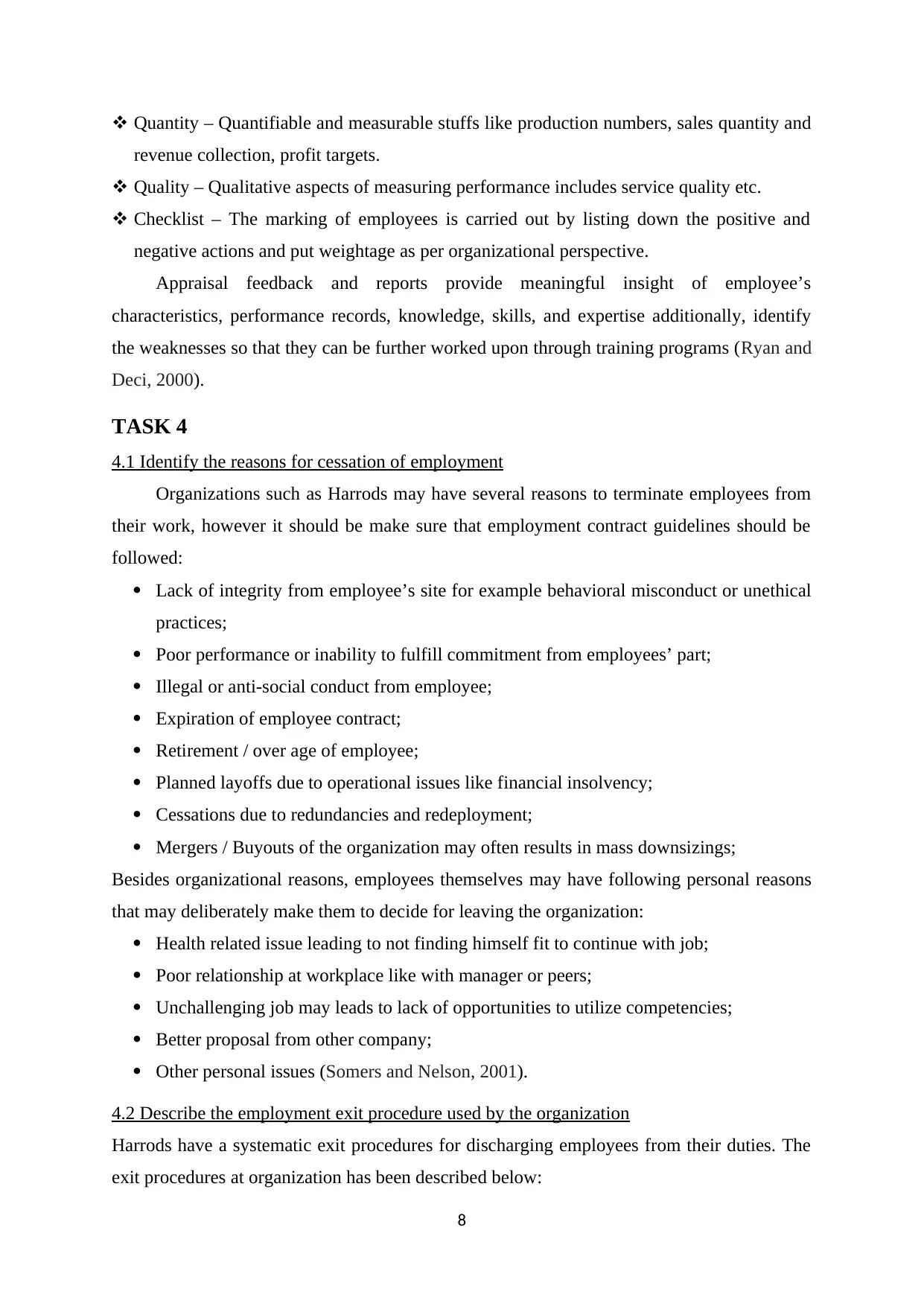
Quantity – Quantifiable and measurable stuffs like production numbers, sales quantity and
revenue collection, profit targets.
Quality – Qualitative aspects of measuring performance includes service quality etc.
Checklist – The marking of employees is carried out by listing down the positive and
negative actions and put weightage as per organizational perspective.
Appraisal feedback and reports provide meaningful insight of employee’s
characteristics, performance records, knowledge, skills, and expertise additionally, identify
the weaknesses so that they can be further worked upon through training programs (Ryan and
Deci, 2000).
TASK 4
4.1 Identify the reasons for cessation of employment
Organizations such as Harrods may have several reasons to terminate employees from
their work, however it should be make sure that employment contract guidelines should be
followed:
Lack of integrity from employee’s site for example behavioral misconduct or unethical
practices;
Poor performance or inability to fulfill commitment from employees’ part;
Illegal or anti-social conduct from employee;
Expiration of employee contract;
Retirement / over age of employee;
Planned layoffs due to operational issues like financial insolvency;
Cessations due to redundancies and redeployment;
Mergers / Buyouts of the organization may often results in mass downsizings;
Besides organizational reasons, employees themselves may have following personal reasons
that may deliberately make them to decide for leaving the organization:
Health related issue leading to not finding himself fit to continue with job;
Poor relationship at workplace like with manager or peers;
Unchallenging job may leads to lack of opportunities to utilize competencies;
Better proposal from other company;
Other personal issues (Somers and Nelson, 2001).
4.2 Describe the employment exit procedure used by the organization
Harrods have a systematic exit procedures for discharging employees from their duties. The
exit procedures at organization has been described below:
8
revenue collection, profit targets.
Quality – Qualitative aspects of measuring performance includes service quality etc.
Checklist – The marking of employees is carried out by listing down the positive and
negative actions and put weightage as per organizational perspective.
Appraisal feedback and reports provide meaningful insight of employee’s
characteristics, performance records, knowledge, skills, and expertise additionally, identify
the weaknesses so that they can be further worked upon through training programs (Ryan and
Deci, 2000).
TASK 4
4.1 Identify the reasons for cessation of employment
Organizations such as Harrods may have several reasons to terminate employees from
their work, however it should be make sure that employment contract guidelines should be
followed:
Lack of integrity from employee’s site for example behavioral misconduct or unethical
practices;
Poor performance or inability to fulfill commitment from employees’ part;
Illegal or anti-social conduct from employee;
Expiration of employee contract;
Retirement / over age of employee;
Planned layoffs due to operational issues like financial insolvency;
Cessations due to redundancies and redeployment;
Mergers / Buyouts of the organization may often results in mass downsizings;
Besides organizational reasons, employees themselves may have following personal reasons
that may deliberately make them to decide for leaving the organization:
Health related issue leading to not finding himself fit to continue with job;
Poor relationship at workplace like with manager or peers;
Unchallenging job may leads to lack of opportunities to utilize competencies;
Better proposal from other company;
Other personal issues (Somers and Nelson, 2001).
4.2 Describe the employment exit procedure used by the organization
Harrods have a systematic exit procedures for discharging employees from their duties. The
exit procedures at organization has been described below:
8
Secure Best Marks with AI Grader
Need help grading? Try our AI Grader for instant feedback on your assignments.
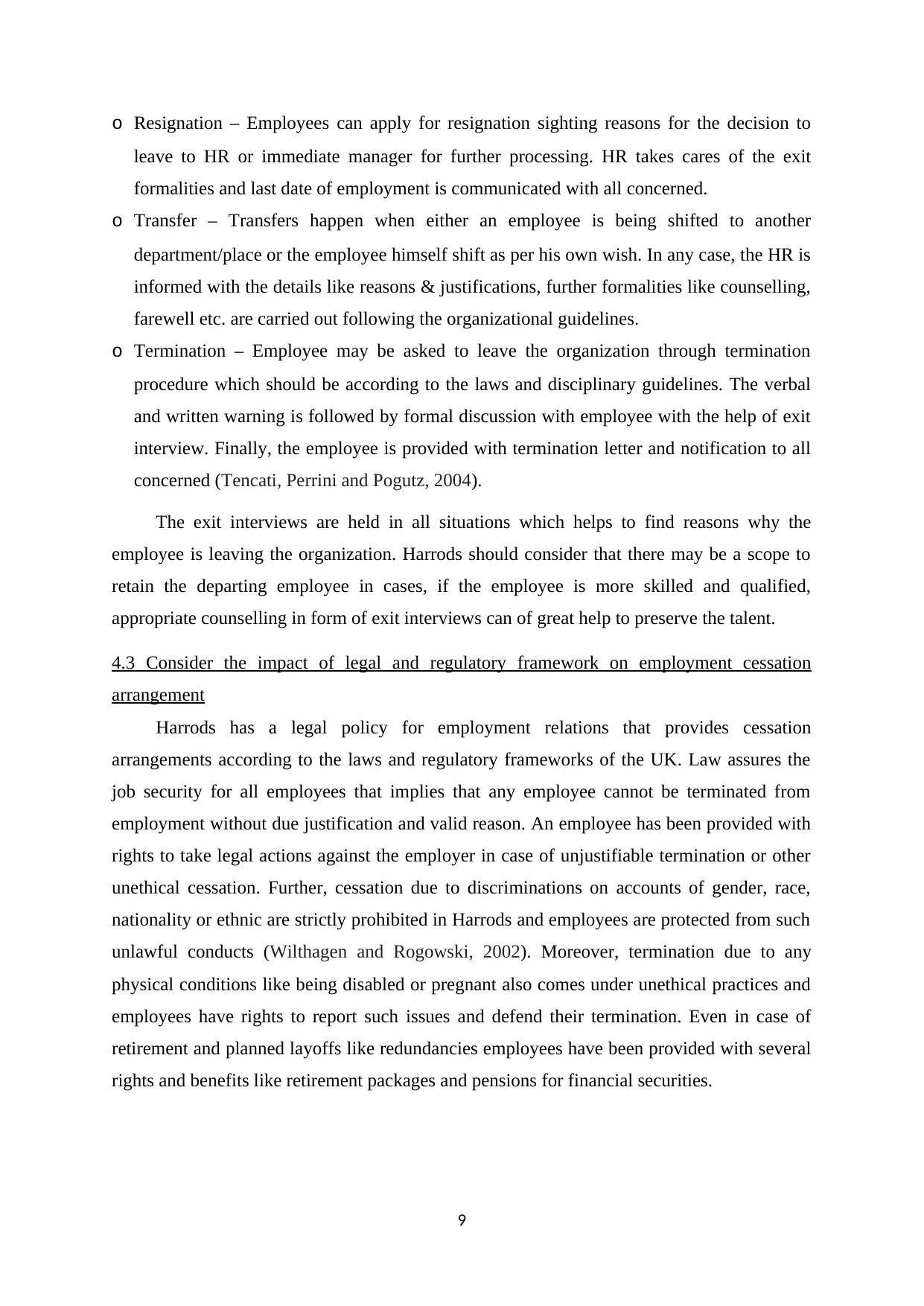
o Resignation – Employees can apply for resignation sighting reasons for the decision to
leave to HR or immediate manager for further processing. HR takes cares of the exit
formalities and last date of employment is communicated with all concerned.
o Transfer – Transfers happen when either an employee is being shifted to another
department/place or the employee himself shift as per his own wish. In any case, the HR is
informed with the details like reasons & justifications, further formalities like counselling,
farewell etc. are carried out following the organizational guidelines.
o Termination – Employee may be asked to leave the organization through termination
procedure which should be according to the laws and disciplinary guidelines. The verbal
and written warning is followed by formal discussion with employee with the help of exit
interview. Finally, the employee is provided with termination letter and notification to all
concerned (Tencati, Perrini and Pogutz, 2004).
The exit interviews are held in all situations which helps to find reasons why the
employee is leaving the organization. Harrods should consider that there may be a scope to
retain the departing employee in cases, if the employee is more skilled and qualified,
appropriate counselling in form of exit interviews can of great help to preserve the talent.
4.3 Consider the impact of legal and regulatory framework on employment cessation
arrangement
Harrods has a legal policy for employment relations that provides cessation
arrangements according to the laws and regulatory frameworks of the UK. Law assures the
job security for all employees that implies that any employee cannot be terminated from
employment without due justification and valid reason. An employee has been provided with
rights to take legal actions against the employer in case of unjustifiable termination or other
unethical cessation. Further, cessation due to discriminations on accounts of gender, race,
nationality or ethnic are strictly prohibited in Harrods and employees are protected from such
unlawful conducts (Wilthagen and Rogowski, 2002). Moreover, termination due to any
physical conditions like being disabled or pregnant also comes under unethical practices and
employees have rights to report such issues and defend their termination. Even in case of
retirement and planned layoffs like redundancies employees have been provided with several
rights and benefits like retirement packages and pensions for financial securities.
9
leave to HR or immediate manager for further processing. HR takes cares of the exit
formalities and last date of employment is communicated with all concerned.
o Transfer – Transfers happen when either an employee is being shifted to another
department/place or the employee himself shift as per his own wish. In any case, the HR is
informed with the details like reasons & justifications, further formalities like counselling,
farewell etc. are carried out following the organizational guidelines.
o Termination – Employee may be asked to leave the organization through termination
procedure which should be according to the laws and disciplinary guidelines. The verbal
and written warning is followed by formal discussion with employee with the help of exit
interview. Finally, the employee is provided with termination letter and notification to all
concerned (Tencati, Perrini and Pogutz, 2004).
The exit interviews are held in all situations which helps to find reasons why the
employee is leaving the organization. Harrods should consider that there may be a scope to
retain the departing employee in cases, if the employee is more skilled and qualified,
appropriate counselling in form of exit interviews can of great help to preserve the talent.
4.3 Consider the impact of legal and regulatory framework on employment cessation
arrangement
Harrods has a legal policy for employment relations that provides cessation
arrangements according to the laws and regulatory frameworks of the UK. Law assures the
job security for all employees that implies that any employee cannot be terminated from
employment without due justification and valid reason. An employee has been provided with
rights to take legal actions against the employer in case of unjustifiable termination or other
unethical cessation. Further, cessation due to discriminations on accounts of gender, race,
nationality or ethnic are strictly prohibited in Harrods and employees are protected from such
unlawful conducts (Wilthagen and Rogowski, 2002). Moreover, termination due to any
physical conditions like being disabled or pregnant also comes under unethical practices and
employees have rights to report such issues and defend their termination. Even in case of
retirement and planned layoffs like redundancies employees have been provided with several
rights and benefits like retirement packages and pensions for financial securities.
9
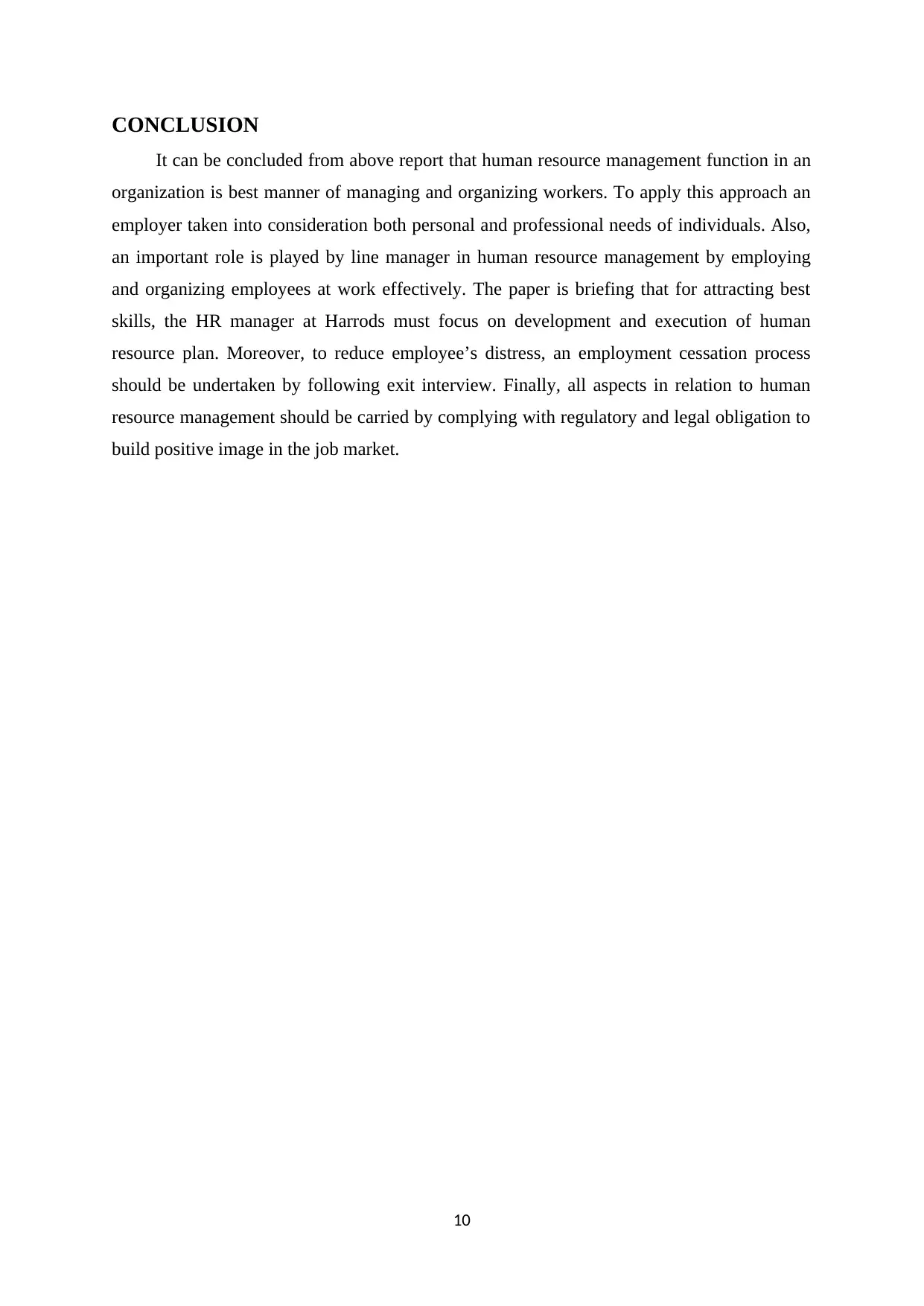
CONCLUSION
It can be concluded from above report that human resource management function in an
organization is best manner of managing and organizing workers. To apply this approach an
employer taken into consideration both personal and professional needs of individuals. Also,
an important role is played by line manager in human resource management by employing
and organizing employees at work effectively. The paper is briefing that for attracting best
skills, the HR manager at Harrods must focus on development and execution of human
resource plan. Moreover, to reduce employee’s distress, an employment cessation process
should be undertaken by following exit interview. Finally, all aspects in relation to human
resource management should be carried by complying with regulatory and legal obligation to
build positive image in the job market.
10
It can be concluded from above report that human resource management function in an
organization is best manner of managing and organizing workers. To apply this approach an
employer taken into consideration both personal and professional needs of individuals. Also,
an important role is played by line manager in human resource management by employing
and organizing employees at work effectively. The paper is briefing that for attracting best
skills, the HR manager at Harrods must focus on development and execution of human
resource plan. Moreover, to reduce employee’s distress, an employment cessation process
should be undertaken by following exit interview. Finally, all aspects in relation to human
resource management should be carried by complying with regulatory and legal obligation to
build positive image in the job market.
10
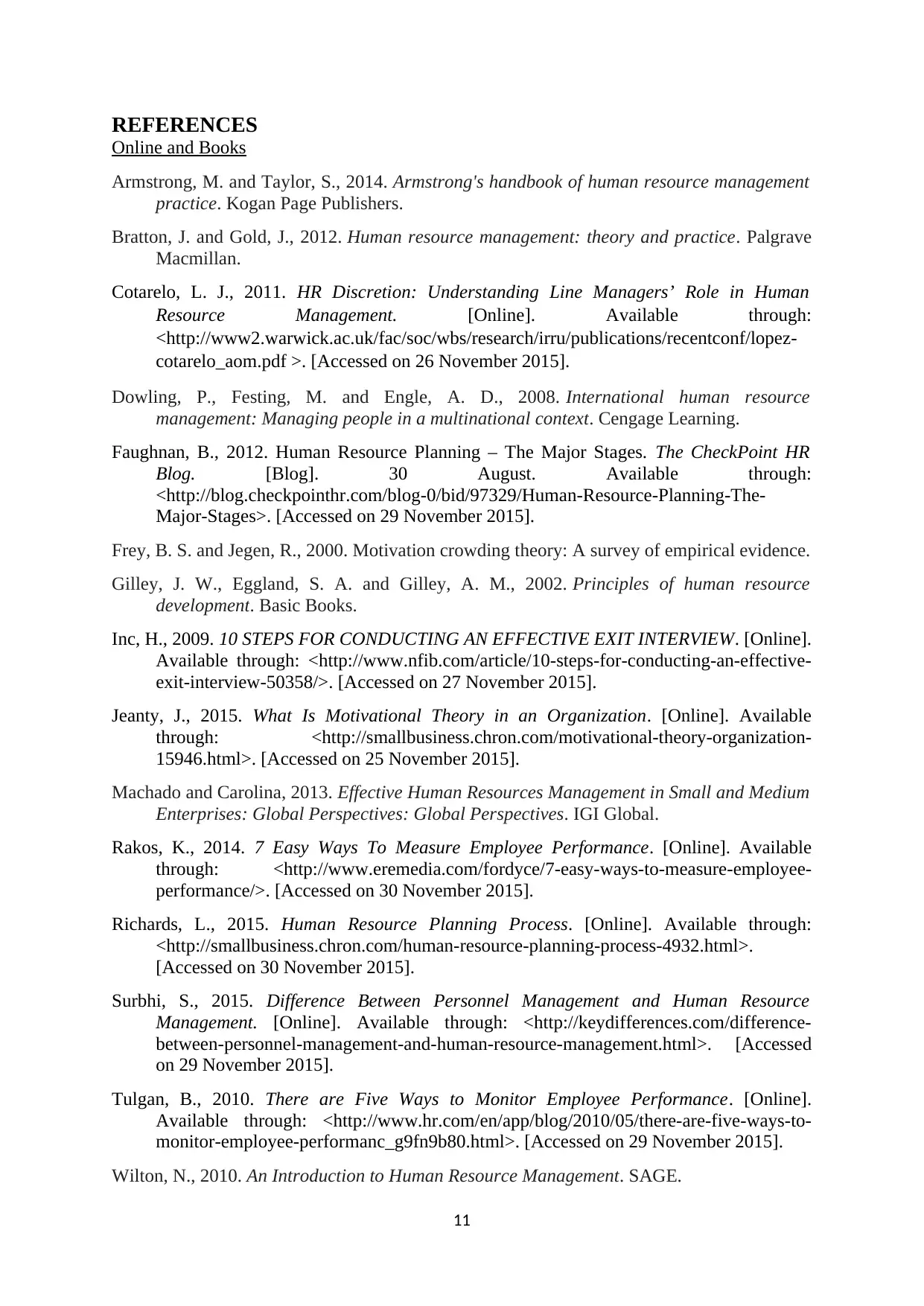
REFERENCES
Online and Books
Armstrong, M. and Taylor, S., 2014. Armstrong's handbook of human resource management
practice. Kogan Page Publishers.
Bratton, J. and Gold, J., 2012. Human resource management: theory and practice. Palgrave
Macmillan.
Cotarelo, L. J., 2011. HR Discretion: Understanding Line Managers’ Role in Human
Resource Management. [Online]. Available through:
<http://www2.warwick.ac.uk/fac/soc/wbs/research/irru/publications/recentconf/lopez-
cotarelo_aom.pdf >. [Accessed on 26 November 2015].
Dowling, P., Festing, M. and Engle, A. D., 2008. International human resource
management: Managing people in a multinational context. Cengage Learning.
Faughnan, B., 2012. Human Resource Planning – The Major Stages. The CheckPoint HR
Blog. [Blog]. 30 August. Available through:
<http://blog.checkpointhr.com/blog-0/bid/97329/Human-Resource-Planning-The-
Major-Stages>. [Accessed on 29 November 2015].
Frey, B. S. and Jegen, R., 2000. Motivation crowding theory: A survey of empirical evidence.
Gilley, J. W., Eggland, S. A. and Gilley, A. M., 2002. Principles of human resource
development. Basic Books.
Inc, H., 2009. 10 STEPS FOR CONDUCTING AN EFFECTIVE EXIT INTERVIEW. [Online].
Available through: <http://www.nfib.com/article/10-steps-for-conducting-an-effective-
exit-interview-50358/>. [Accessed on 27 November 2015].
Jeanty, J., 2015. What Is Motivational Theory in an Organization. [Online]. Available
through: <http://smallbusiness.chron.com/motivational-theory-organization-
15946.html>. [Accessed on 25 November 2015].
Machado and Carolina, 2013. Effective Human Resources Management in Small and Medium
Enterprises: Global Perspectives: Global Perspectives. IGI Global.
Rakos, K., 2014. 7 Easy Ways To Measure Employee Performance. [Online]. Available
through: <http://www.eremedia.com/fordyce/7-easy-ways-to-measure-employee-
performance/>. [Accessed on 30 November 2015].
Richards, L., 2015. Human Resource Planning Process. [Online]. Available through:
<http://smallbusiness.chron.com/human-resource-planning-process-4932.html>.
[Accessed on 30 November 2015].
Surbhi, S., 2015. Difference Between Personnel Management and Human Resource
Management. [Online]. Available through: <http://keydifferences.com/difference-
between-personnel-management-and-human-resource-management.html>. [Accessed
on 29 November 2015].
Tulgan, B., 2010. There are Five Ways to Monitor Employee Performance. [Online].
Available through: <http://www.hr.com/en/app/blog/2010/05/there-are-five-ways-to-
monitor-employee-performanc_g9fn9b80.html>. [Accessed on 29 November 2015].
Wilton, N., 2010. An Introduction to Human Resource Management. SAGE.
11
Online and Books
Armstrong, M. and Taylor, S., 2014. Armstrong's handbook of human resource management
practice. Kogan Page Publishers.
Bratton, J. and Gold, J., 2012. Human resource management: theory and practice. Palgrave
Macmillan.
Cotarelo, L. J., 2011. HR Discretion: Understanding Line Managers’ Role in Human
Resource Management. [Online]. Available through:
<http://www2.warwick.ac.uk/fac/soc/wbs/research/irru/publications/recentconf/lopez-
cotarelo_aom.pdf >. [Accessed on 26 November 2015].
Dowling, P., Festing, M. and Engle, A. D., 2008. International human resource
management: Managing people in a multinational context. Cengage Learning.
Faughnan, B., 2012. Human Resource Planning – The Major Stages. The CheckPoint HR
Blog. [Blog]. 30 August. Available through:
<http://blog.checkpointhr.com/blog-0/bid/97329/Human-Resource-Planning-The-
Major-Stages>. [Accessed on 29 November 2015].
Frey, B. S. and Jegen, R., 2000. Motivation crowding theory: A survey of empirical evidence.
Gilley, J. W., Eggland, S. A. and Gilley, A. M., 2002. Principles of human resource
development. Basic Books.
Inc, H., 2009. 10 STEPS FOR CONDUCTING AN EFFECTIVE EXIT INTERVIEW. [Online].
Available through: <http://www.nfib.com/article/10-steps-for-conducting-an-effective-
exit-interview-50358/>. [Accessed on 27 November 2015].
Jeanty, J., 2015. What Is Motivational Theory in an Organization. [Online]. Available
through: <http://smallbusiness.chron.com/motivational-theory-organization-
15946.html>. [Accessed on 25 November 2015].
Machado and Carolina, 2013. Effective Human Resources Management in Small and Medium
Enterprises: Global Perspectives: Global Perspectives. IGI Global.
Rakos, K., 2014. 7 Easy Ways To Measure Employee Performance. [Online]. Available
through: <http://www.eremedia.com/fordyce/7-easy-ways-to-measure-employee-
performance/>. [Accessed on 30 November 2015].
Richards, L., 2015. Human Resource Planning Process. [Online]. Available through:
<http://smallbusiness.chron.com/human-resource-planning-process-4932.html>.
[Accessed on 30 November 2015].
Surbhi, S., 2015. Difference Between Personnel Management and Human Resource
Management. [Online]. Available through: <http://keydifferences.com/difference-
between-personnel-management-and-human-resource-management.html>. [Accessed
on 29 November 2015].
Tulgan, B., 2010. There are Five Ways to Monitor Employee Performance. [Online].
Available through: <http://www.hr.com/en/app/blog/2010/05/there-are-five-ways-to-
monitor-employee-performanc_g9fn9b80.html>. [Accessed on 29 November 2015].
Wilton, N., 2010. An Introduction to Human Resource Management. SAGE.
11
Paraphrase This Document
Need a fresh take? Get an instant paraphrase of this document with our AI Paraphraser
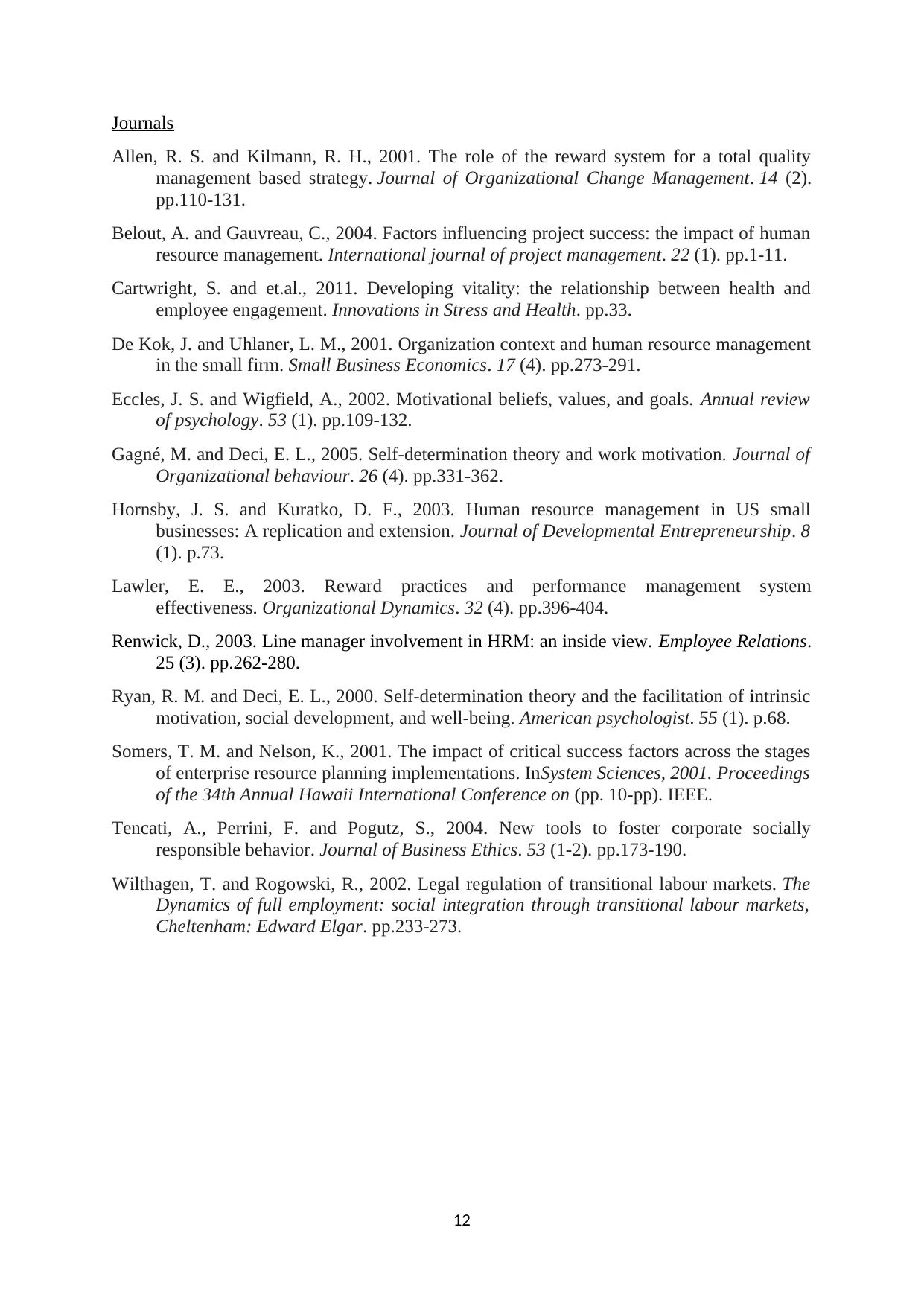
Journals
Allen, R. S. and Kilmann, R. H., 2001. The role of the reward system for a total quality
management based strategy. Journal of Organizational Change Management. 14 (2).
pp.110-131.
Belout, A. and Gauvreau, C., 2004. Factors influencing project success: the impact of human
resource management. International journal of project management. 22 (1). pp.1-11.
Cartwright, S. and et.al., 2011. Developing vitality: the relationship between health and
employee engagement. Innovations in Stress and Health. pp.33.
De Kok, J. and Uhlaner, L. M., 2001. Organization context and human resource management
in the small firm. Small Business Economics. 17 (4). pp.273-291.
Eccles, J. S. and Wigfield, A., 2002. Motivational beliefs, values, and goals. Annual review
of psychology. 53 (1). pp.109-132.
Gagné, M. and Deci, E. L., 2005. Self-determination theory and work motivation. Journal of
Organizational behaviour. 26 (4). pp.331-362.
Hornsby, J. S. and Kuratko, D. F., 2003. Human resource management in US small
businesses: A replication and extension. Journal of Developmental Entrepreneurship. 8
(1). p.73.
Lawler, E. E., 2003. Reward practices and performance management system
effectiveness. Organizational Dynamics. 32 (4). pp.396-404.
Renwick, D., 2003. Line manager involvement in HRM: an inside view. Employee Relations.
25 (3). pp.262-280.
Ryan, R. M. and Deci, E. L., 2000. Self-determination theory and the facilitation of intrinsic
motivation, social development, and well-being. American psychologist. 55 (1). p.68.
Somers, T. M. and Nelson, K., 2001. The impact of critical success factors across the stages
of enterprise resource planning implementations. InSystem Sciences, 2001. Proceedings
of the 34th Annual Hawaii International Conference on (pp. 10-pp). IEEE.
Tencati, A., Perrini, F. and Pogutz, S., 2004. New tools to foster corporate socially
responsible behavior. Journal of Business Ethics. 53 (1-2). pp.173-190.
Wilthagen, T. and Rogowski, R., 2002. Legal regulation of transitional labour markets. The
Dynamics of full employment: social integration through transitional labour markets,
Cheltenham: Edward Elgar. pp.233-273.
12
Allen, R. S. and Kilmann, R. H., 2001. The role of the reward system for a total quality
management based strategy. Journal of Organizational Change Management. 14 (2).
pp.110-131.
Belout, A. and Gauvreau, C., 2004. Factors influencing project success: the impact of human
resource management. International journal of project management. 22 (1). pp.1-11.
Cartwright, S. and et.al., 2011. Developing vitality: the relationship between health and
employee engagement. Innovations in Stress and Health. pp.33.
De Kok, J. and Uhlaner, L. M., 2001. Organization context and human resource management
in the small firm. Small Business Economics. 17 (4). pp.273-291.
Eccles, J. S. and Wigfield, A., 2002. Motivational beliefs, values, and goals. Annual review
of psychology. 53 (1). pp.109-132.
Gagné, M. and Deci, E. L., 2005. Self-determination theory and work motivation. Journal of
Organizational behaviour. 26 (4). pp.331-362.
Hornsby, J. S. and Kuratko, D. F., 2003. Human resource management in US small
businesses: A replication and extension. Journal of Developmental Entrepreneurship. 8
(1). p.73.
Lawler, E. E., 2003. Reward practices and performance management system
effectiveness. Organizational Dynamics. 32 (4). pp.396-404.
Renwick, D., 2003. Line manager involvement in HRM: an inside view. Employee Relations.
25 (3). pp.262-280.
Ryan, R. M. and Deci, E. L., 2000. Self-determination theory and the facilitation of intrinsic
motivation, social development, and well-being. American psychologist. 55 (1). p.68.
Somers, T. M. and Nelson, K., 2001. The impact of critical success factors across the stages
of enterprise resource planning implementations. InSystem Sciences, 2001. Proceedings
of the 34th Annual Hawaii International Conference on (pp. 10-pp). IEEE.
Tencati, A., Perrini, F. and Pogutz, S., 2004. New tools to foster corporate socially
responsible behavior. Journal of Business Ethics. 53 (1-2). pp.173-190.
Wilthagen, T. and Rogowski, R., 2002. Legal regulation of transitional labour markets. The
Dynamics of full employment: social integration through transitional labour markets,
Cheltenham: Edward Elgar. pp.233-273.
12
1 out of 14
Related Documents
Your All-in-One AI-Powered Toolkit for Academic Success.
+13062052269
info@desklib.com
Available 24*7 on WhatsApp / Email
![[object Object]](/_next/static/media/star-bottom.7253800d.svg)
Unlock your academic potential
© 2024 | Zucol Services PVT LTD | All rights reserved.





